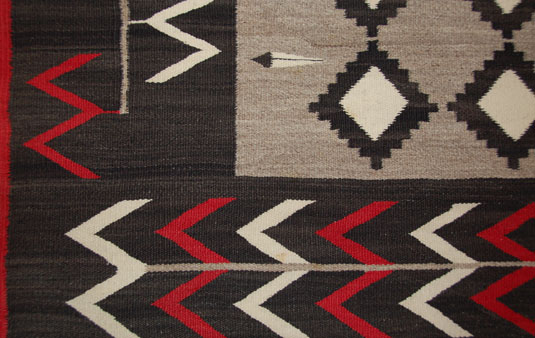Crystal Trading Post Pictorial Rug [SOLD]
+ Add to my watchlist Forward to Friend
- Category: Navajo Textiles
- Origin: Diné of the Navajo Nation
- Medium: wool, dye
- Size: 5’ 8” x 3’ 9”
- Item # C3755C SOLD
Crystal Trading Post in New Mexico has a place in the history of Navajo textiles unlike any other post of its time except Ganado Trading Post in Arizona—and that time was in the first quarter of the 20th century. The first permanent trading post business in the Chuska Mountains was established in 1894 by Joe Wilkin and Elmer Whitehouse. Two years later, Joe Reitz bought out Whitehouse and J. B. Moore bought out Wilkin. The following year, Moore became the sole owner of the post and named it Crystal after a very pure and sparkling mountain spring that ran by the post.
Crystal Trading Post, located at about 8,000 feet in elevation received much snow in the winter and it was not feasible to freight in supplies, a most likely reason for a rapid succession of traders. Moore’s solution was to create a catalog of Navajo rugs and blankets, jewelry and other items which he could sell by mail order during the long cold winters when there were no visitors. His first catalog was published in 1903 and featured 8 Navajo rugs, jewelry, and other items for sale. He then added 5 more as loose leaf mailers. Then, in 1911, Moore published his masterpiece—a second catalog which brought the total number of available rug patterns to 31.
Because of an unfortunate incident for which Moore was not responsible, he departed the trading post in 1911 shortly after his second catalog was published. He never saw the results of this new approach to marketing the arts of the Navajo whom he admired so much.
The styles and patterns of the 31 rugs Moore published were continued for a time and then weavers introduced modified versions as the years passed. This rug, from the 1920s, still shows influence from Moore but shows a weaver’s changes. It is an amazing combination of a black wide border surrounding an all-natural grey inner panel with diamonds and feathers. The outer border is comprised of wool from brown and black sheep with no added dye, the grey is a carded blend of white wool and black wool, and the red is the only source of dye. Perhaps the red and white elements in the wide border represent the letter M in honor of Moore?
Condition: excellent condition and has just been cleaned so it is ready for use
Recommended Reading: J. B. Moore, United States Licensed Indian Trader: Collection of Catalogs Published at Crystal Trading Post 1903-1911. Avanyu Publishing, 1987
Provenance: from a family from Colorado

- Category: Navajo Textiles
- Origin: Diné of the Navajo Nation
- Medium: wool, dye
- Size: 5’ 8” x 3’ 9”
- Item # C3755C SOLD



